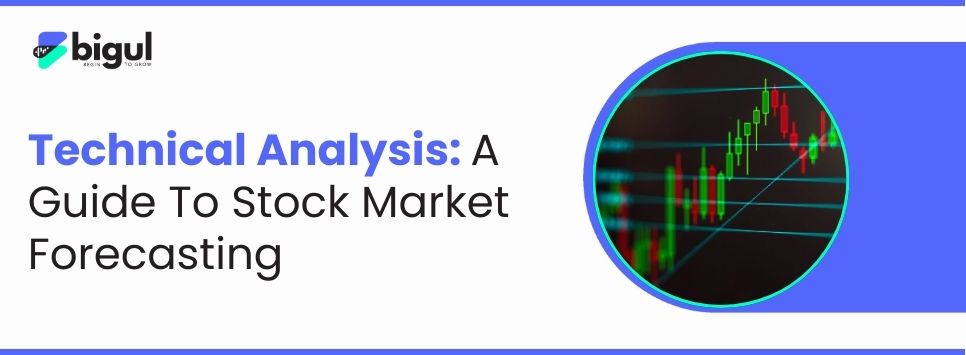A popular method used by traders and investors to predict the future direction of stock or currency prices is technical analysis. Rather than examining a company's accounts, technical analysis examines data in the market, such as historical prices and volume of trade. The premise is that past price action and trading can indicate what the market will do next.
Simply put, technical analysis explains how much a security is being sold and purchased. It enables traders to know when to sell or buy using various charts. Though it is primarily for short-term trading, its concepts can also assist you in determining whether a security is becoming stronger or weaker relative to the rest of the market.
Interpreting Technical Analysis
Technical analysis is a technique of trading whereby good trading opportunities are discovered by examining historical market activity, such as price movements and the amount traded. It is analysing what the market is doing, primarily through the use of charts, to attempt to predict where prices will move next.
Rather than reading the financial reports of a company, technical analysts think that all significant information is contained within the price. Technical analysis studies how the market is acting, and not why it is acting as such.
Charles Dow and his Dow Theory, which originated in the late 1800s, established the basis for today's use of technical analysis. Other studies would be conducted by William P. Hamilton, Robert Rhea and John Magee and help develop the basic principles into the complex systems we have today.
Use of Technical Analysis In Stock Market
Technical analysis is predominantly a way to make well-informed guesses of the direction of prices and of the way to find trades. It is frequently employed by professional analysts together with other research, such as fundamental analysis, to construct a more robust trading plan. Yet, most individual traders, particularly those seeking quick profits, employ it as their sole source of guidance.
Technical analysis can be used on any type of security that has a trading history, including stocks, futures, currencies and cryptocurrencies. It is very common in commodity and currency markets, since traders will keep an eye on short-term price movements. The practice itself is considered to be a clear indication of demand and supply in the market.
Although it typically measures price fluctuations, there are also other statistics that are followed, such as trading volume or open interest levels, by analysts in order to have a clearer impression of market sentiment.
Technical Analysis Charts Used in the Stock Market
Charts are the key to technical analysis. They are images that depict a security's price movements through time, and they enable you to visualize trends and sentiment in the market. The most popular forms of charts are:
Line Chart:
This is the most basic chart, with a line connecting the closing prices with time. It provides a clear, straightforward picture of a trend but does not reflect much about daily price changes.
OHLC Bar Chart:
This chart employs tall bars to represent price variation with respect to time. The top of each bar is represented by the highest price for that given period, and the lowest price represents the bottom of each bar.
Candlestick Chart:
It gives the same info as a bar chart but is more visually appealing. When the price closes higher than it started, the candlestick pattern is said to be bullish (white or green). A black or red bearish candle is one in which the price closed below its opening.
Technical Indicators for Stock Market
Technical traders can take advantage of hundreds of created patterns and signals. These are quantitative tools that examine price or volume in order to know what a stock can do next. They are intended to assist traders with understanding trends and market momentum and/or possible buy or sell signals.
Main Categories of Technical Indicators Include:
-
Price trends: these indicators, including moving averages, give a big picture idea of the market direction.
-
Chart patterns: unique shapes on a chart that suggest that a price trend will either reverse direction or continue in motion.
-
Momentum and volume indicators: guide the trader to understand how fast and/or strong a price trend is moving.
-
Oscillators: measures that oscillate between two extremes to indicate when a price level is either overbought (likely to decline) or oversold (likely to increase)
-
Support and resistance levels: Significant prices where a security price will likely reverse direction and stop.
Widely used Technical Indicators :
Moving Averages (MA):
A Moving Average displays the primary direction, or trend, of an individual stock's price. You can think of it as smoothing out a nasty bumpy road to see the path. Whereas every mini movement up and down would be looked at, a Moving Average provides one line that grows over time (50 days, 200 days, etc.) that will always represent the average price over time.
Using a moving average allows us to conveniently disregard some insignificant price variations (noise) which can exaggerate the noticeability of the price direction. Various kinds of moving averages exist, including the most popular being the Simple Moving Average (SMA) and the Exponential Moving Average (EMA).
The Relative Strength Index (RSI):
RSI is a tool to determine if the stock's price has moved too quickly, too much. Essentially, it displays the stock's momentum in a numerical format, indexed from 0 to 100. If the RSI indicates a value above 70, the stock is most likely overbought and indicates that it has risen too quickly and is due for a pause or a drop.
When the RSI shows a measurement of less than 30, it is likely that the stock is oversold; this implies that the price has dropped too fast and is possibly ready to make a rebound. Traders use these measurements as a quick way to determine if the price of a stock is too high or too low, in the short term
Moving Average Convergence Divergence (MACD):
It is also a widely used momentum following indicator that reflects the results of two moving averages. There are three key things that it comprises.:
-
The MACD line is formed by taking a longer-period moving average and subtracting a shorter-period moving average.
-
Identify the signal line by averaging the MACD line
-
A histogram represents the difference between the MACD line and the signal line.
Stock Traders receive buy and sell signals from the MACD in two ways:
Crosses:
When the MACD line crosses the signal line upward it may indicate markets are rising - this is a buy signal. A sell signal occurs when the MACD line crosses below the signal line and provides an indication of market momentum reversing in direction.
Divergences:
This is when the price is moving in the opposite direction of the MACD line. For instance, when a stock price makes a new high but the MACD line doesn't, it may indicate that the trend will reverse since the buying power is weakening.
Bollinger Bands:
An indicator that has a middle moving average line and has two bands that are either above or below. The bands are constructed to indicate the degree to which the market is in motion and overbought or oversold at the extremes.
The Underlying Concepts Of Technical Analysis
Technical analysis attempts to comprehend the sentiments in the market underlying price trends by seeking patterns. The approach is founded on three key ideas that expand on Charles Dow's two original concepts:
The market already reflects everything:
Technical analysts are of the view that everything ranging from the value of a company to general market conditions and market sentiment is already reflected in a stock price. Efficient Markets Hypothesis (EMH) also reaches the same conclusion. All one has to do is interpret the price actions, which they view as a function of supply and demand.
Price trend:
Technical analysts think that there is a price trend (either up, down, or sideways) since prices do not just happen at random. A stock should maintain its prior trend rather than abruptly reverse it. This assumption is the foundation of most trading schemes.
History repeats itself:
This concept is founded on the belief that the behavior of the market can be predicted since human sentiments such as fear and greed tend to repeat themselves over time.
Method Used for Technical Analysis
Technical analysis applies many methods to locate and capitalise on market trends.
Chart Patterns:
The analysts seek certain shapes in charts to indicate potential price reversals or trends that will persist. Some examples include Head and Shoulders, Double Tops/Bottoms, and Triangles.
Trend Analysis:
It is identifying and recognising the trend direction and its power. Analysts also use trend lines and moving averages to identify whether a security is in a bull market (upward trend) or bear market (downward trend).
Support and Resistance:
These are significant price levels where the price of a security is likely to bottom out and turn around. A support is a price level where buyers should be strong enough to hold and prevent the price from dropping. A resistance is a price level where sellers will show up, preventing the price from advancing further.
Volume Analysis:
A large price change with high volume tends to reinforce the fact that a trend exists. On the other hand, a low volume price movement can be a sign of a lack of commitment and a possible reversal
What Makes Up A Trend Line
A trend line is a straight line on a chart that forms a line between a series of prices, telling you the price direction of a trend. It is a simple tool you can utilise to analyse price direction and support or resistance with a trend line. There are 3 elements of a trend line:
Trend:
The trend line slope direction - up (bullish), down (bearish) and level (sideways) is likely the most basic element of any trend line. To indicate a trend, join the low points for an uptrend and high points for a downtrend.
Support and Resistance:
A trend line tends to behave as moving support or resistance for the price. It is a technical analysis tool planned to offer a price reference for trend direction where price trends find either support prices or resistance prices. When in an uptrend, the line behaves as a support, indicating that buyers are likely to intervene every time the price falls to the line. When in a downtrend, it behaves as a resistance since sellers are likely to emerge every time the price moves up to the line.
Number of Touchpoints:
A trend line is drawn with at least two points, but the line has more validity when it has three or more points of reference to support it. The established trend line is as strong as the number of times it has been "tested" (price touches the trend line) and holds.
Technical And Fundamental Analysis – Difference
Aspect |
Technical Analysis |
Fundamental Analysis |
|
Definition |
Predicts using price, volume, and trends. |
Uses a company’s finances and economic variables to determine its value. |
|
Focus |
Price movements, trends, and market sentiment. |
The value of the company, the performance of the company, the economic statistics. . |
|
Data Used |
Price charts, volume, and indicators. |
Financial reports, ratios, and economic facts. |
|
Timeframe |
Short- to medium-term trading. |
Long-term investing. |
|
Who uses it |
Traders, short-term decision-makers. |
Long-term investors. |
|
Criticism |
Can disregard fundamental facts and is subject to varying interpretations. |
May be slow to react to new fashion trends and may miss the optimal time to sell or purchase. |
Merits Of Technical Analysis
Unambiguous Signals: It provides unambiguous signals to buy and sell, which is crucial to handle risk
Objective Information: It involves objective information (price and volume) and hence is direct and methodical in its trading approach.
Adaptable: You can apply it to any security or to any market (stocks, currencies) and to any time frame.
Risk management: It assists you in achieving proper stop-loss orders to manage losses by establishing key support and resistance points.
Demerits Of Technical Analysis:
Subjective: Various analysts may view the same chart and come to different conclusions.
May Provide Deceptive Signals: It may not function under all market situations and can provide deceptive signals, particularly in nonsensical markets. This takes skill and experience.
Self-Fulfilling Prophecy: A main criticism is that it sometimes works simply because enough people use the same signals. For example, if many traders place a stop-loss order below a certain moving average, the price hitting that point could cause a wave of selling, making the price drop just as traders expected.
Conclusion
Technical analysis is simply using price and volume data to try to forecast the next price change of a security (stock) in the form of a chart, which is usually displayed, and when a professional trader / investor uses a chart, they would use many of the technical indicators that you can use to help them make situations for when to enter or exit trades.
Although prices are random according to some experts, this technique is highly popular and still in practice. It provides a clear and evidence-based manner of making trading decisions, particularly for short-term trading. When combined with fundamental analysis, it provides you with a comprehensive picture which can significantly enhance the capability of the trader to deal with the complex financial market and manage risk effectively.
FAQs
1. What is technical analysis in stock trading?
Technical analysis is a technique of trading whereby good trading opportunities are discovered by examining historical market activity, such as price movements, trends and the amount traded. It is analyzing what the market is doing, primarily through the use of charts.
2. What are the most widely used technical indicators?
Some of the most widely used technical indicators are Moving Averages, RSI, MACD, Bollinger Bands, and Support/Resistance levels.
3. Is technical analysis useful for beginners?
Yes indeed, the analysis can be used by any type of stock market trader and investor to understand the price trends and even predict future movements based on historical data.
4. Can technical analysis be used for automated/ algo trading?
Yes, it is possible for stock traders to apply technical indicators to make auto buy and sell decisions while doing algo trading/bot trading.


.jpg)






.jpg)
.jpg)
